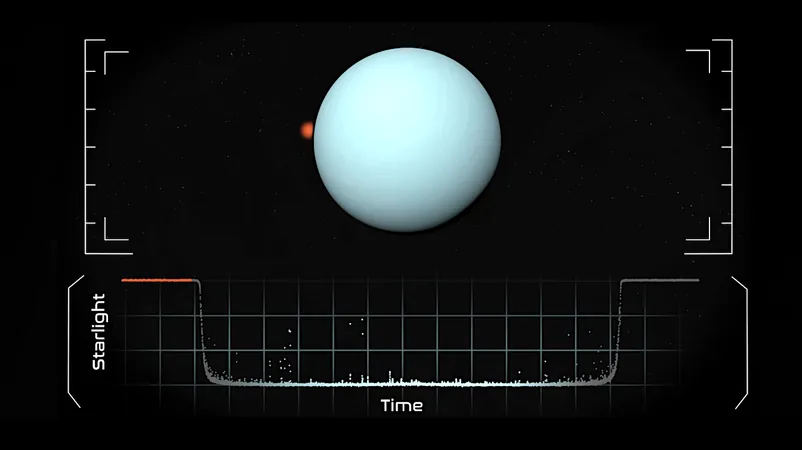
NASA Unveils Secrets of Uranus: Stunning Stellar Occultation Reveals Atmospheric Mysteries
2025-05-13
Author: Mei
Prepare for an interstellar revelation! On April 7, 2025, NASA took advantage of a rare cosmic alignment when Uranus lined up perfectly between Earth and a distant star, unveiling a trove of atmospheric secrets about the ice giant. This astronomical phenomenon, known as a stellar occultation, offered scientists a golden opportunity to probe the depths of Uranus' stratosphere.
During this spectacular occurrence, Uranus eclipsed a star located an astounding 400 light-years away, creating a dazzling effect as the planet's atmosphere refracted the starlight. "As Uranus obscured the star's light, it appeared to dim until it was completely blocked, with the reverse happening at the end. We captured this captivating shift in what we call a light curve," explained William Saunders, a planetary scientist at NASA's Langley Research Center.
This light curve is more than just a pretty graph; it contains critical data on temperature, density, and pressure within Uranus’ stratosphere. Comparing this information to data from the last significant occultation over 30 years ago could reveal how the atmosphere has evolved, offering vital insights for future exploration.
The occultation event lasted about an hour and was exclusively observable from Western North America. NASA assembled an impressive international team of over 30 astronomers using 18 observatories to capture this rare event. The collaboration marked a significant milestone in astronomical teamwork, with each participant contributing a unique perspective on the phenomena.
Kunio Sayanagi, leading the Uranus Stellar Occultation Campaign 2025, noted the immense value of this cooperative effort. "NASA's observations will help us understand energy movements within Uranus' atmosphere and unravel the mystery of its unusually hot upper layers. But that’s not all—this data will also facilitate measurements of Uranus' rings and atmospheric turbulence, as well as its precise orbit around the Sun.”
Nailing down Uranus' orbit is crucial but surprisingly tricky. The last spacecraft to visit the planet, NASA's Voyager 2, flew by in 1986, years before the last bright occultation took place in 1996. Currently, Uranus' position can only be pinpointed within about 100 miles, highlighting the importance of the new atmospheric data.
Adding to the excitement, the team had previously conducted a successful test run in November 2024, coordinating observations from telescopes in Japan and Thailand for a dimmer occulation. This preparatory phase enabled NASA to refine their strategies, ultimately leading to the triumphant April event.
Uranus, 2 billion miles from Earth, is a mesmerizing ice giant with an atmosphere rich in hydrogen and helium and uniquely lacks a solid surface, instead featuring soft layers of water, ammonia, and methane. Often overshadowed by Saturn, Uranus boasts 13 rings, composed of ice and dust, further adding to its allure.
Looking ahead, NASA is gearing up for more stellar occultation events, with hopes to capture airborne and possibly space-based measurements of an even brighter star eclipsed by Uranus in 2031. This captivating journey into the cosmos is just beginning!
Stay updated on NASA's daring adventures with the Uranus Stellar Occultation Campaign 2025, exploring the unexplored and unlocking the mysteries of our universe!



 Brasil (PT)
Brasil (PT)
 Canada (EN)
Canada (EN)
 Chile (ES)
Chile (ES)
 Česko (CS)
Česko (CS)
 대한민국 (KO)
대한민국 (KO)
 España (ES)
España (ES)
 France (FR)
France (FR)
 Hong Kong (EN)
Hong Kong (EN)
 Italia (IT)
Italia (IT)
 日本 (JA)
日本 (JA)
 Magyarország (HU)
Magyarország (HU)
 Norge (NO)
Norge (NO)
 Polska (PL)
Polska (PL)
 Schweiz (DE)
Schweiz (DE)
 Singapore (EN)
Singapore (EN)
 Sverige (SV)
Sverige (SV)
 Suomi (FI)
Suomi (FI)
 Türkiye (TR)
Türkiye (TR)
 الإمارات العربية المتحدة (AR)
الإمارات العربية المتحدة (AR)